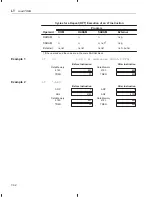
LACT
Load Accumulator With Shift Specified by TREG
7-78
Syntax
LACT
dma
Direct addressing
LACT
ind [, ARn]
Indirect addressing
Operands
dma:
7 LSBs of the data-memory address
n:
Value from 0 to 7 designating the next auxiliary register
ind:
Select one of the following seven options:
* *+ *– *0+ *0– *BR0+ *BR0–
LACT
dma
15
14
13
12
11
10
9
8
7
6
5
4
3
2
1
0
0
1
1
0
1
0
1
1
0
dma
LACT
ind [, ARn]
15
14
13
12
11
10
9
8
7
6
5
4
3
2
1
0
0
1
1
0
1
0
1
1
1
ARU
N
NAR
Note:
ARU, N, and NAR are defined in Section 6.3,
Indirect Addressing Mode (page 6-9).
Execution
Increment PC, then ...
(data-memory address)
×
2
(TREG(3:0))
→
ACC
If SXM = 1:
Then (data-memory address) is sign extended.
If SXM = 0:
Then (data-memory address) is not sign extended.
Status Bits
Affected by
SXM
Description
The LACT instruction loads the accumulator with a data-memory value that
has been left shifted. The left shift is specified by the four LSBs of the TREG,
resulting in shift options from 0 to 15 bits. Using the four LSBs of the TREG as
a shift code provides a dynamic shift mechanism. During shifting, the high-or-
der bits are sign extended if SXM = 1 and zeroed if SXM = 0.
LACT may be used to denormalize a floating-point number if the actual expo-
nent is placed in the four LSBs of the TREG register and the mantissa is refer-
enced by the data-memory address. This method of denormalization can be
used only when the magnitude of the exponent is four bits or less.
Words
1
Opcode
















































